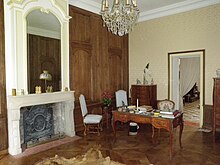Château de Sandaucourt
The Château de Sandaucourt , formerly a moated castle , is located in the municipality of Sandaucourt in the west of the Vosges department in the Grand Est region , France .
history
Sandaucourt Castle was probably built by Aloff de Beauvau or his half-brother Claude, the ruler of Sandaucourt, 1549–1553. When he died in 1553, two of his sons-in-law, Claude de Reinach (councilor and chamberlain to Duke Charles III of Lorraine , Seneschal of Barrois ) and Jean de Damas , shared ownership of the castle. This common ownership lasted until 1715 and saved the castle during the Thirty Years War . Because when the French troops occupied the village in 1636, they spared the castle because the Fulligny-Damas followers of Louis XIII. who were king of France. This was not the case for the other family branch of the castle owners, which can be established in the grandson of Claude de Reinach, Colonel of the Infantry Jean-Jacques de Haraucourt (1600–1644), in the service of Duke Charles IV of Lorraine . De Haraucourt's wife Alberte-Barbe d'Ernécourt (1607–1660), then known as the Christian Amazon , was unlike her husband, however, remained loyal to the King of France.
Several times visited Cardinal de Retz (1613-1679), the friend of his former lords of Sandaucourt, Louis of Armoises and Jean Nicolas de Fulligny-Damas, so on November 3, 1672 on the occasion of the christening of his godson Jean-François Paul de Fulligny-Damas , the son of one of his hosts.
In 1715 the castle was sold to the Spanish Marquis d'Amenzuaga de Riscal d'Alegre, husband of Baroness Suzanne de Chauviray. He sold the property in 1735 to the principal customs leaseholder of Lorraine, Sigisbert Richard, who in turn sold it in 1770 to François de Saint-Ligier, one of Louis XV. ennobled Maréchal de camp passed on. The castle was extensively renovated in the 18th century: it was no longer necessary to fill the moat, the windows were enlarged, a staircase, a veranda and a balcony were added to the main facade and two symmetrical pavilions were built at the entrance to the property, extended by one horseshoe wall. François de Saint-Ligier did not get along with his wife Agnes de Bry d'Artois, a former socialite of Queen Maria Leszczyńska . He had already left the castle when the French Revolution broke out , and only his wife lived there with their two sons. By marriage, the castle fell to the Sciviaux de Greische, the last noblemen to own it.
The castle was acquired in 1931 by the company Paul Couillard and Cie from Nancy, which used the cellar for cheese processing . In 1969 it was sold to the Breuil Girardel company, which converted it into accommodation for immigrants who worked in the Manuest factory, a production subsidiary of the food manufacturer Vogica in neighboring Châtenois .
Restoration work began in 1976 after the acquisition of the castle by Dr. Kirsch and his wife Marthe-Odile Lersy. These include woodwork on individual pieces, the grand staircase and staircase, the pavilions and the outbuildings. On April 2, 1980, the façades and roofs of the palace and the pavilions, the access steps and its wrought-iron ramp were declared a monument historique by the French Ministry of Culture . The interior of the portico, in which a chapel has been restored, is fully protected as a historical monument. In 2000, Dr. Kirsch donated the castle to the Lorraine Museum based in Nancy, which was rejected by the latter. Eventually Matthieu Cognet, the owner of the Châteaux de Thuillières , acquired the property and has since continued the work of Dr. Kirsch continued the restoration work. The castle is open to the public from July 1st to August 15th.
Web links
Individual evidence
Coordinates: 48 ° 15 ′ 48.7 " N , 5 ° 50 ′ 51.6" E

